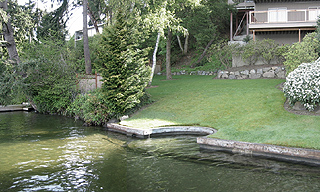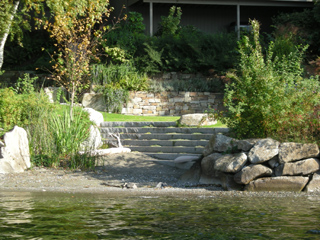
Surveys
DJC.COM
June 26, 2008
Homeowners rethink their waterfronts
The Watershed Co.

Way
|
Eagles perch in the trees, muskrats haul out on the beach, and sockeye salmon spawn along the shoreline at Elizabeth and Bill Baxter’s home within five minutes of downtown Bellevue.
“We feel like we are camping every day. It’s magical for our family,” notes Elizabeth Baxter as she talks about a shoreline reconstruction and relandscaping of the couple’s Lake Washington front yard.
The Baxters’ project is part of a slowly growing trend throughout Washington to deconstruct bulkheads and hardened lake shorelines and replace them with natural elements. Shoreline restoration is coming to the fore just as stream and wetland restoration did 20 years ago with citizens and government recognizing the critical role lakefronts play in salmon recovery, healthy ecological function and water quality.

Photos courtesy of The Watershed Co. The Baxter home on Lake Washington used to have a bulkhead that made beach access impossible. |
New tougher state, federal and local shoreline regulations and listing of salmon under the Endangered Species Act have pressed hundreds of property owners who want to build new docks or lakefront homes to restore damaged waterfront as part of permit approval. Some property owners are choosing to use natural techniques because they want to do something good for the environment. And many communities are working on new plans and regulations that will reverse a long trend of shoreline degradation.
But, there is a long way to go. A 2001 study showed that 71 percent of Lake Washington’s shoreline had been bulkheaded. Many other urban and rural lakes throughout Washington have some level of shoreline hardening as well, which may worsen as development pressure increases.
Now 39 counties and 200 cities in the state must revisit their shoreline planning and regulation by 2016 through the Shoreline Master Program Update. Required by the Legislature and Washington Department of Ecology, the process is an outgrowth of a state shoreline protection law originally passed in 1971 called the Shoreline Management Act. It requires communities to involve local citizens in the development of policies and regulations for management and protection of lake, stream and river shorelines. It also asks for updated inventories of shoreline condition and studies of the cumulative impacts of development, as well as a comprehensive shoreline restoration plan.
SMP updates
The goal is to protect and encourage water-dependent uses and public access to the water, and to include the latest scientific knowledge about environmental protection, according to Joe Burcar, shoreline planner at the Department of Ecology, who is working with local governments.
To date only four jurisdictions have completed SMP updates; dozens of others are under way with some intense public debate and creative solutions to balance environmental protection and property use, including incentives and public education.

A landscape change softened the slopes while new logs and gravel created an inviting shoreline for both wildlife and the Baxters. |
“We see people in two camps when it comes to lakeshore restoration,” Burcar says. “Those who are skeptical and worry about their property, and those who believe the new natural techniques look much better and want to do the right thing by using a softer approach.”
Count the Baxters as believers. No beach access, a failing and dangerous bulkhead, a sinkhole, exposed sewer pipes, and erosion created by heavy waves prompted them to do extensive research and make dramatic changes guided by scientists and landscape architects from The Watershed Co. They re-graded lawn to create a natural beach instead of a vertical drop. Then they saved mature trees, removed broken concrete and rocks, and installed habitat logs and native plantings. Waves that used to swamp them are now attenuated and deflected, and children and adults can play safely in the water.
“The Baxters’ experience is truly a model that we can point to that inspires others,” says Heidi Bedwell, environmental planner at the city of Bellevue, co-manager of Bellevue’s Shoreline Master Program Update.
Bob and Molly Cadranell are also believers and another positive restoration example. They converted a 45-boat Lake Union marina and repair facility into an eight-unit floating home moorage, which required extensive permitting and shoreline mitigation.
“People stop and ask us if this is a park. I guess it is,” Molly Cadranell says about the 140 feet of street end they restored with native plants, logs and beach gravels as part of redevelopment.
The Cadranells reduced over-water cover on their site by almost 20,000 square feet or 65 percent. They cut critical nearshore cover by 82 percent, making their shoreline more hospitable for a variety of aquatic life, particularly juvenile salmonids. Unnatural in-water debris, including broken concrete, was removed.
Besides the green space, what the Cadranells like about their new beach is its low maintenance. Canada geese, which prefer tender lawn shoots to shrubs, pass them by, and roots from native plants check shoreline erosion.
“We’re glad that we had to do it. Bulkheads are so passé,” Molly Cadranell says.
Incentives work
Trip Rumberger, president of Pella Windows Northwest, took advantage of shoreline restoration incentives offered by the city of Sammamish when he received approval to build a new cabana on Lake Sammamish by removing rockery and crumbling concrete, then restoring natural shoreline with significant native plant relandscaping.
“We wouldn’t have been able to build without the incentives,” Rumberger says. “We complained at first, but we love the look and the fact it’s fish friendly now that it’s done.”
Lake Sammamish, an icon for the new city of Sammamish, has faced tremendous development pressure with the redevelopment of smaller homes and recreational properties along the lake into large new homes, according to Kamuron Gurol, director of community development.
Recognizing that its natural shoreline was deteriorating fast, the Sammamish City Council two years ago approved dramatic new critical areas regulations specifically directed for protecting the lake. A new 45-foot lake buffer was created and applied to new construction and significant remodels. However, property owners can reduce the buffer down to match the old 20-foot shoreline setback by removing bulkheads, planting native vegetation, eliminating lawn and controlling pesticide use.
“We wanted to use a bunch of carrots instead of a stick. Over time, I think we’ll see neighbors create peer pressure for restoration along the shoreline,” says Gurol.
Sammamish’s creative approach won an award from the Washington Chapter of the American Planning Association.
The city of Bellevue is just beginning its Shoreline Master Program Update process with a survey of citizen opinion about lake and stream shorelines. It has also tried a public education approach to sensitive area restoration by publishing a critical areas handbook.
Illustrated with planting plans for stream, wetland, steep slopes and lakeshore restoration, the manual has become an invaluable tool to help citizens easily understand how to improve their properties in an environmentally sensitive manner.
“An informed and educated public can balance what’s good for fish and wildlife with public access and property rights,” says Bedwell of Bellevue, who managed creation of the handbook and is co-managing the SMP.
Nancy Way is vice president of The Watershed Co., a Kirkland environmental consulting company with services in stream, wetland, shoreline and wildlife assessment, planning, permitting and restoration design. The firm is celebrating its 25th year.
Other Stories:
- Corporate social responsibility turns green
- A green approach to gold mining in the Okanogan
- Financing evolves to benefit the environment
- Will Earthships save the Earth?
- Municipalities discover the benefits of eco-roofs
- What lies ahead for sustainable design?
- Planning our communities for a low-carbon future
- City, tribe team up on clean water project
- Architectural firm sets a zero-energy goal
- New stormwater discharge challenges loom
- Green building’s future lies in innovation, conservation
- Seattle becomes a hotbed for clean technologies
- Speed up sustainable development with a planned-action EIS
- Avoiding fish-related construction delays
Copyright ©2009 Seattle Daily Journal and DJC.COM.
Comments? Questions? Contact us.